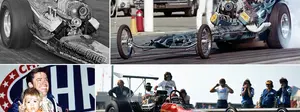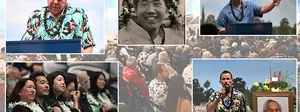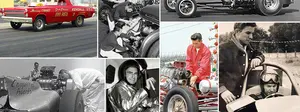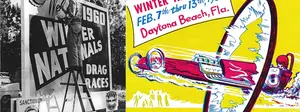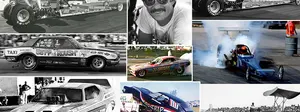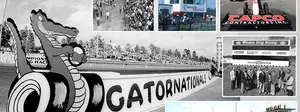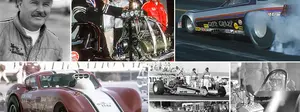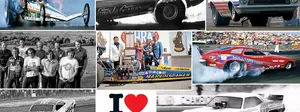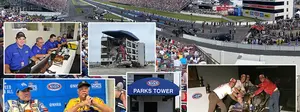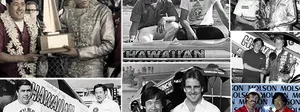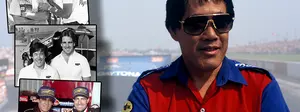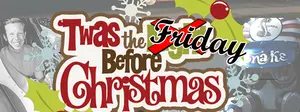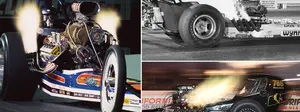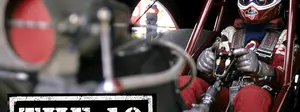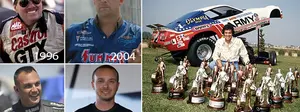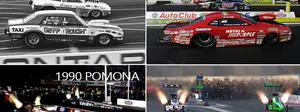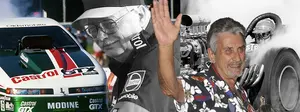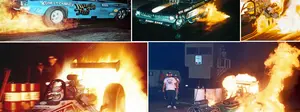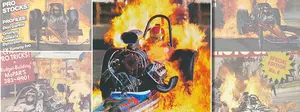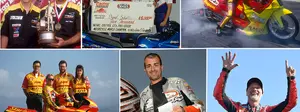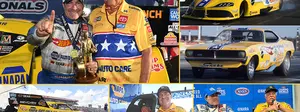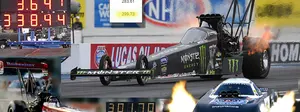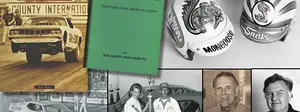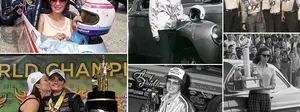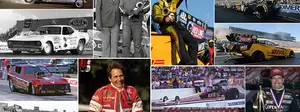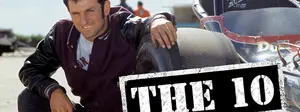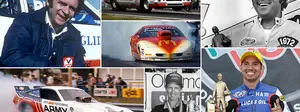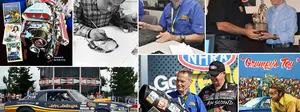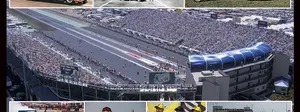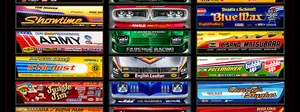Bill "Maverick" Golden
 |
 Before he became one of the godfathers of wheelstanding, Golden earned his "Maverick" nickname with a succession of highly successful Dodge doorslammers. |
The Little Red Wagon Dodge A-100 truck wheelstander may be one of the most iconic and well-known machines to ever traverse the quarter-mile, unique in its original design and purpose, built in plastic model form by legions of young boys like myself, and loved by fans across the continent. Bill “Maverick” Golden, the man who helped bring the Little Red Wagon into our lives and popularize the wheelstanding craze, died last week at age 81.
Truth be told, the Little Red Wagon wheelstander was one of those happy accidents that occur from time to time in life, and Golden was the man who helped make it a sensation, but his ascension to the cockpit of the wild machine was hardly the result of chance.
Golden, a former Marine, was given his “Maverick” nickname by a Southern California dragstrip announcer in the late 1950s because of his choice of machine: an unconventional 361-powered Dodge Custom Royal. But Golden, who originally hailed from Shawnee Town, Ill., but relocated to SoCal while serving in the motor pool at Camp Pendleton, found the magic in his Mopars, and subsequent machines established him as a local doorslammer legend. When he stunned the sport by beating "Dyno Don" Nicholson's factory-backed 409 Chevrolet at the 1962 AHRA Winternationals at Fontana Drag City, the folks at Chrysler really took notice.
He had already been on a "parts deal" with the automaker for two years when Chrysler representatives arranged for him to run a brand-new 413-powered S/SA Dodge that year, and Golden rewarded them with the Winternationals win, the only win by a Chrysler product at the event.
By tinkering with everything from shift points to low-drag piston rings to low-pressure valve springs to instant full-advance distributors, Golden, who was employed at the Douglas Aircraft factory, stayed solidly ahead of the pack and capped 1962 by winning a huge race at Lions Drag Strip over a field of 149 factory drivers. His 1963 entry, a Dodge 330, was consistently several tenths ahead of its rivals and often parked in the winner’s circle and was voted as one of the Top 10 Super Stockers of all time.
In 1964, Dodge gave Golden one of its new 426 Hemi-powered Dodge 330 factory racers to run on AHRA’s Ultra Stock circuit, where again he was the cream of the crop. But his life changed forever later that year when Frank Wylie, Chrysler's chief of public relations, invited him to Dick Branster's shop in Troy, Mich., to see their latest project, a Dodge pickup intended for the Factory Experimental wars.
 Early version of the Little Red wagon, pre-wheelstander days. |
 Golden developed a rear-brake-controlled steering system (above) and a wheelie-height management system (below) to perfect his aerial act. |
 |
 Golden's success with the Wagon encouraged similar machines and competition, including Chuck Poole's familiar Chuckwagon. |
Chrysler was seeking some promotion for its line of pickups, and the conventional front-engine D-100 was already out there, but not the cab-over A-100. Chrysler engineers Jim Schaeffer and John Collier were given the duty to transform the household hauler into a dragstrip hauler. They added a tubular subframe and replaced the anemic slant six engine with a carbureted 426 Hemi and Torqueflite transmission that they located about 20 inches further rearward than the stock drivetrain. This was no small feat as it required an approximate 33-by-19-inch opening in the rear of the cab and a similar-sized hole in the bed to receive the engine. The stock doors were replaced with fiberglass units, and the spare tire (41 pounds), heater (34 pounds), dash panel, front bumper, and body sealer were removed to shave weight.
The truck ran mid-11s at 120 mph, but besides being quite loose on the top end — no doubt due to its short 90-inch wheelbase — the truck had a propensity toward wheelstands due to its new front-rear weight-distribution ratio (48/52, as opposed to the stock 58/42 ratio). Branster Enterprises, which had built Roger Lindamood’s Color Me Gone Dodge, a Top Stock winner at the 1964 Nationals, was brought into the equation to solve the former and did so by adding a pivoting subframe, and with injectors replacing the dual-quad carburetors, one of Branster’s fabricators, Jay Howell, got the test-pilot duties, but Chrysler ended up giving the car to its golden boy, Golden. (I wrote about Howell’s experiences with the Little Red Wagon and other wild rides in this 2009 column: The life and times of Jay Howell.)
Golden’s first outing with the truck — still thought of as a race car and not as an exhibition car — was at the 1965 AHRA Grand American event at Lions Drag Strip. With the tailgate open and the rear bumper scraping the pavement, the Little Red Wagon made a quarter-mile pass in 11 seconds at 120 mph, with the car doing seven wheelstands during the pass. The crowd went nuts — reports are that the cops had to be called in to control the fans — and the light went on in Golden’s mind.
Over the winter of 1965, Golden developed a guidance system for the Little Red Wagon. Perhaps inspired by the aircraft he was always around at the Douglas plant, he mounted huge Hurst disc brakes on both rear wheels, and using a set of hand controls near the steering wheel, he could lock and unlock each rear wheel independently to steer the truck when the front wheels were clawing for the sky. In fact, at many points during the run, his hands weren’t even on the steering wheel.
Golden also developed a system for controlling the height of his wheelstands and how much traction he wanted using the rear wheels and tailgate, the latter of which was equipped with eight independently controlled shock absorbers to dial in just the right angle based on track and weather conditions. In 1970, he reconfigured the cockpit to center steer, which gave him a better “feel” of where he was on the track.
All told, there were four Little Red Wagons. The first and second trucks were crashed or trashed during the 1960s and pieced together to make the third, and a fourth was built in the 1970s and ran until Golden retired in 2003. That final Wagon ended up in Don Garlits’ Museum of Drag Racing.
The number of runs that Golden performed for fans is in the thousands, and Golden claimed to not have let little things like snowstorms, rain, or 30-mph crosswinds ground the Little Red Wagon.
“People come to see me run,” he said, “and I don’t like to let them down.”

 |
Golden’s nephew, Chuck Winters, who was part of the Little Red Wagon crew, remembered his uncle fondly in some emails we exchanged after his passing.
“When he and Teresa were married in 2000 at National Trail Raceway, the Little Red Wagon was the best man, but instead of walking back up the aisle, they roared down the track with a small wheelie, to NHRA's disapproval, but ‘Maverick’ was always a maverick.”
He then shared with me this great tale, from “Broadway Bob” Metzler’s Great Lakes Dragaway, that speaks to the showmanship that fans enjoyed over the many decades:
In 1976, "Maverick" got an idea that his fans might like to see a fire show. If a fire show is done properly, it is spectacular, to say the least. This one was no exemption. We needed another man to help pull the flame burnout off right. "Broadway" supplied him and said if we needed anything else just ask and it’s ours. "Broadway’s" man, however, had never even heard of a fire show, much less seen one, but we instructed him on what we wanted him to do.
We rolled the wagon to the staging area and prepared for a show. I told our new helper that we would do a regular burnout, back up, do a quick wheelie, then the flame burnout — simple.
Everything went according to plan until the flame burnout. "Maverick" backed the wagon into the staging area. Our helper had already poured a gallon of gas on the asphalt, and my job was to direct "Maverick" into the gas. Just as the wagon rolled back into the gas, the helper lit it and stood there. This was NOT according to the plan!
The flames shot up and around the wagon. My heart leaped into my throat like a bat out hell, but "Maverick" didn’t move. He sat there calmly adjusting his gloves and goggles. He couldn’t see that the fire was lit. I thought that the fuel tank, which was mounted in the rear of the truck, would explode. "Maverick" looked up to see me doing everything but handsprings trying to signal GO! GO! He hammered the throttle, and the flames exploded into the night. I caught a glimpse of our new helper running away, all elbows and tennis shoes, with flames chasing him in hot pursuit. The crowd screamed wildly. We dodged that bullet.
 |
Now the firewall. The wall was constructed of two-by-fours covered with burlap sacks, baling wire, and gas. The mixture of gas to the formula is very scientific: Dump five gallons over it and toss a match. This will produce a very nice wall of fire. But a very nice wall of fire was not good enough for "Broadway." He instructed his crew to up it to 10 gallons. When they lit that thing, it came to life like a raging beast! If we could see under his mask, I would lay odds that his jaw was gaping. Mine was. The whole track was visible.
The Tree staged, ran down to green, and the Little Red Wagon launched off of the line, hurling itself toward the inferno on the rear wheels. I could barely watch. When the wagon plowed through the raging fire, sparks and debris flew everywhere. I didn’t know if it was a success or if "Maverick" was flipping end over end on the other side of that bonfire. The crowd went absolutely nuts! I hopped in a rescue truck and headed toward the scene. We were about 100 feet from the fire when we saw something move on the other side. Another second, and we realized what it was. Yep, you guessed it, it was "Maverick" in the Little Red Wagon. That was good.
 Golden was inducted into the International Drag Racing Hall of Fame in 2003. |
What was bad — VERY BAD — was that he was heading straight at us in a full-powered wheelie. We were fixin’ to meet Mr. Showman in a whole new fashion. Us at 60 mph and him at over 100. Now I won’t lie to ya and tell ya that I sat there staring danger in the face and spit in its eye and all of that. I will tell ya that I damn near had a heart attack! The driver yelled out, "Hold on!" It actually sounded more like a screaming little girl, but who’s counting? Thank heavens "Broadway" had constructed his dragstrip with grass lanes between the track and the guardrail. We drove the truck into the grass and held on! "Maverick" dropped the wagon on the crowd side of the fire and got out to take his bows. We stopped the rescue truck on the backside of the fire, got out, and cleaned our pants.
True to his motto as a pure showman: "Always give the crowd what they want.”
True to that, when Golden was inducted into the International Drag Racing Hall Of Fame in 2003, it was with a memorable speech that clocked in at somewhere around 40 minutes.
Well, maybe he gave the crowd a little more than what they wanted, but that was Bill “Maverick” Golden.


